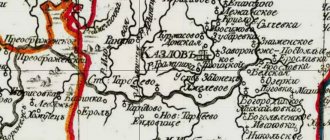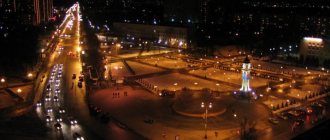The Church of the Sign of the Blessed Virgin Mary in Dubrovitsy is perhaps one of the most memorable churches in the Moscow region. It stands out, first of all, for its appearance - completely uncharacteristic for Orthodox churches. We have seen pictures of this church more than once, but we saw it with our own eyes only a few months ago, when we went to see two estates in the Podolsk district of the Moscow region - “Dubrovitsy” and “Ivanovskoye”. They will be discussed today in our report. The first mention of the Dubrovitsy estate dates back to 1627, when it was owned by boyar I.V. Morozov. After his death, his daughter Ksenia, who married Ivan Andreevich Golitsyn, became the owner of the estate. In 1690, Boris Alekseevich Golitsyn and Peter the Great laid the first stone in the construction of the Znamenskaya Church. Nowadays, most tourists come to the Dubrovitsy estate to see first of all the Church of the Sign of the Virgin Mary, and only then the manor house and park.
History of the Church of the Sign of the Blessed Virgin Mary in Dubrovitsy
Peter I not only participated in the laying of the temple, but also often came to Dubrovitsy to give his instructions on the decoration. Construction of the church was completed in 1697, but it was consecrated later, in 1704. The fact is that Patriarch Adrian did not give permission to consecrate the church, since, in his opinion, it was very similar to Catholic churches.
In 1700, the patriarch died and his place was taken by Stefan Yavorsky, who did not see anything Catholic in the Znamenskaya Church. But another problem arose - Peter the Great could not come to Dubrovitsy until the fall of 1703, and as a result, the temple was consecrated only in February 1704, that is, 7 years after the completion of construction.
The external appearance of the Church of the Sign of the Blessed Virgin Mary amazes with its sculptural compositions - you would expect to find a similar church in Dresden rather than in the near Moscow region.
Before the Znamenskaya Church appeared in Dubrovitsy, on the same site there was a wooden temple of Elijah the Prophet, which in 1690 was moved to the village of Lemeshevo. A stone was installed on the site of the throne of the Temple of the Prophet Elijah, but in the 20th century it was lost and recreated only in 2004.
Until 1932, there was a bell tower next to the Church of the Sign, but in Soviet times it suffered the fate of many Orthodox churches - it was destroyed. Very few images of the bell tower have survived to this day.
To the right of the Church of the Sign there is an observation deck and a bridge with “love” locks, traditional for all estates. Behind the site, next to the Singing Field, you can see Marina Tsvetaeva’s stone, although the great poetess herself was never here.
Personalities
Count Arseny Andreevich Zakrevsky
Count A.A. Zakrevsky , 1785-1865, son of a Tver nobleman, Lieutenant Andrei Ivanovich, born September 15, 1785; was brought up in the Grodno Cadet Corps and, at the age of 19, was released as an ensign in the Arkhangelsk Gorodets Regiment; participated in the campaigns of 1805-1807, where he earned a number of distinctions and was appointed adjutant to the young gr. Kamensky, whose life was saved at Austerlitz. In Moldova, during the assault on Rushchuk, he was shell-shocked in the arm and leg, and for the battle of Batina he received an horde. St. George 4th Art. After the death of Kamensky, he was appointed director of the office of the Minister of War. He took part in the Patriotic War and received St. Vladimir 5th class; On December 5 he was promoted to adjutant wing; for the campaigns of 1815 and 1811 promoted to major general and granted adjutant general on October 8, 1815. From the generals on duty, on August 30, 1825, he was appointed Governor-General of Finland. Emperor Nicholas I appointed him a member of the Supreme Court of the Decembrists, and on April 19, 1828, Minister of Internal Affairs, with the appointment of the Finnish Governor-General. On August 5, 1850, V. Prince was elevated to the title of count. Finnish. When cholera appeared, he was sent with enormous powers to fight it, but these measures did not stop the terrible “cholera-morbus”, and the extreme autocracy of the count caused the displeasure of the Sovereign. On November 19, 1851, Zakrevsky left the service and remained out of work for 17 years. On May 6, 1818, the count was again appointed adjutant general and Moscow military governor-general. After Prince Shcherbatov, Moscow needed to be brought up in view of the ghosts of the revolution and the noticed vacillation of minds... “and the notorious Count Zakrevsky fell on the sleeping city with a rocket from Congreve”; the no less notorious Prince Menshikov said then that Moscow had become “not only a saint, but also a great martyr.” The following year, Zakrevsky was appointed a member of the State Council and received St. Andrew's Star, and Alexander II, on the day of his coronation, granted him his portrait with a gracious rescript. Zakrevsky's dismissal on April 16, 1859 was a complete surprise and followed the fact that his only, spoiled daughter, Count. Lydia Nesselrode from her living husband, with the knowledge of her father, was married to Prince. Drutsky-Sokolinsky and went abroad with a passport illegally given by the Governor General. The Count informed the Tsar only when it was no longer a secret. After leaving the post of Governor General, Zakrevsky lived mostly in Italy and died in Florence on January 11, 1865; buried in his estate, "Galereto", near Florence. Having received the meager education, without any patronage, Zakrevsky owed everything only to himself and often spoke with pride about his “straight path” and the “purity of his intentions.” A. N. Ermolov, gr. Kiselev, Bulgakov brothers, gr. The Vorontsovs were his friends and recognized his outstanding abilities and impeccable honesty; they even found in him a sympathetic heart and a kind soul, for the majority, however, somewhere deeply hidden under an icy shell; even his ill-wishers considered him a far from ordinary person. Alien to any liberal tendencies, with his common sense he clearly saw the shortcomings of the reality around him, and he cannot be denied an understanding of political events; He had a particularly negative attitude towards the activities of Arakcheev, whom he called “a plague”, “a snake” and “the only state villain”. But arrogance, harshness and inaccessibility brought him closer to this hated temporary worker, and he was loved by few people, although he himself did not notice it. In Moscow, where he arrived at the end of his days, Zakrevsky insisted that he “needed to be stern in appearance,” and was seriously convinced that ruling the capital was only “patriarchal,” in its spirit, being a defender of the right and a threat to everyone evil; however, thanks to the heavy guardianship over the townsfolk, administrative arbitrariness and the espionage system, for the majority Zakrevsky was a capricious and suspicious despot who put his will outside the law, while still being accessible to outside influence, starting with his frivolous daughter and ending with his valet, the famous Matvey. A man of unyielding will and iron character, the formidable count, before whom everything trembled, succumbed to the onslaught of his family and appeared helplessly weak before the whims of his beloved, kind, but whimsical wife, Count. Agrafena Fedorovna, who caused him quite a lot of grief as a person and as a spouse.
(Portrait of Count A.A. Zakrevsky. 1820 I. Sergiev (I. Sergeev?))
Countess Agrafena Fedorovna Zakrevskaya
1. Countess A.F. Zakrevskaya , 1800-1879, daughter of gr. Fyodor Andreevich Tolstoy, married to Stepanida Alekseevna Durasova, granddaughter of the rich man Myasnikov. The only child in the family, the favorite of her Old Believer grandmother, “Grushenka” was spoiled by an eccentric father who could “set an example for all sorts of nonsense,” and she herself madly loved her mother, who came from an environment of complete darkness and superstition. Her childhood passed amid complete idleness; as a beautiful girl, she fluttered around the balls with her rejuvenating father. A passionate lover of French novels, with which she spent all her free time, in moments of grief she crossed herself in the schismatic style with “two fingers.” A split will made her unbalanced: infinitely kind, seemingly capricious, a “flighty laugher,” she, “a slave to a tormenting dream,” suffered “in the anguish of spiritual emptiness,” and her “convulsive joy” quickly turned into hysterical sobs. “Like Magdalene, you cry, and like a mermaid, you laugh”! Baratynsky wrote about her. On September 27, 1818, she married the 35-year-old dry pedant Zakrevsky and did not bring “peace and prosperity” to his house. After 5 years, carried away by “her dreary dream,” she went abroad for treatment, and they did not expect her to return. “I heard,” wrote Bulgakov, “that at a ball in Florence, Coburg announced that he could not go with her to Livorno; she fainted and had a regular seizure"; but several days passed and she returned: “You can imagine Zakrevsky’s joy: A.F. is fresh as a rose, somewhat kinder, very cheerful and happy to be here. The same kind of flightiness, talking about 10 subjects at one time”... In Finland, she gave favor to young people who were with her husband, but Count enjoyed her special favor. Armfeld. On July 18, 1820, her only daughter Lydia was born. Her hobbies continued and were as frequent as her disappointments were quick; She made Pushkin her “confidant,” and he, “burning with the flame of love, with his head down, jealously,” listened to her “confession” and wrote: “But stop your stories; hide, hide your dreams: I’m afraid of their fiery infection, I’m afraid to find out what you knew!” The poet envied the lucky man, “with whom you are clearly in love, whose gaze dominates you,” and this “lucky man” (in 1828) was another poet, Baratynsky; enchanted by her charming beauty, caught in her “magic net,” he sang of the insane laughter of his “mermaid”:
How much you have lived and felt in just a few days! In the rebellious flame of passions, how passionately you burned out!
2. 20 years passed in Moscow, and evil tongues still surrounded her; Here, too, she gathered young people around her, who owed their career successes with the count to her patronage; the most risky adventures were attributed to her; she was “not embarrassed by anything.” Moscow had fun at balls and performances at her dacha (Studenets) and in Ivanovsky, Podolsk district, but her evenings in Moscow were not successful: “strict Moscow ladies shied away from her company,” which, however, did not upset her much: she always “ she loved only the company of men and did not know how to talk to ladies.” “Delicate with inferiors, affectionate with everyone, valuing every service dearly, she did not know how to refuse requests and could not see tears; the predominant feature of her character was kindness, reaching the point of weakness.” She generously gave charity, but indiscriminately; she wanted to help everyone, but often to the detriment of justice; she was perfectly in place next to the inaccessible and formidable count and saved many; Even the Old Believers, who were persecuted at that time, thanks to her, found in Zakrevskoye an intercessor before Filaret himself. After the death of her husband, Zakrevskaya lived in the summer in Livorno, and the rest of the year in Florence, where she died in the winter of 1879. She was buried in the tomb next to her husband. Not stupid by nature, who subordinated people of outstanding intelligence and strong character to her weak will, Zakrevskaya had major shortcomings, which were redeemed by the high qualities of her heart. Pushkin successfully sketched her “portrait” with a few elegant strokes:
With her flaming soul, with her stormy passions, Oh, wives of the North, she sometimes appears among you, And strives past all the conditions of the world until she loses strength, - Like a lawless comet in the circle of calculated luminaries.
( 1. Portrait of Count A.F. Zakrevskaya. 1810s. Unknown artist; 2. From a miniature belonging to Count D.I. Tolstoy, in St. Petersburg)
History of the Dubrovitsy estate
The manor house in Dubrovitsy was built in the mid-17th century, but at that time it was two-story. In 1919, the estate building housed a museum of noble life, but in 1927 it was closed, the exhibits were taken to Moscow, Serpukhov and Tsaritsyno, and the building itself was transferred to an orphanage. In 1932, an agricultural technical school was located in the estate.
In 1961, the owners changed again, and the building was occupied by the All-Union Scientific Research Institute of Animal Husbandry. Four years later, for an unknown reason, the manor house burned down, but restoration work carried out in 1966-1970 returned the manor to its former appearance. In 2003, a new stage of restoration began, which continues today.
Near the manor house there is a beautiful linden park and a horse yard. The Dubrovitsy estate is one of the most popular places for registering a marriage, because the Podolsk regional registry office is located on its territory. So if you want to hold a wedding ceremony like a king, welcome to Dubrovitsy!








